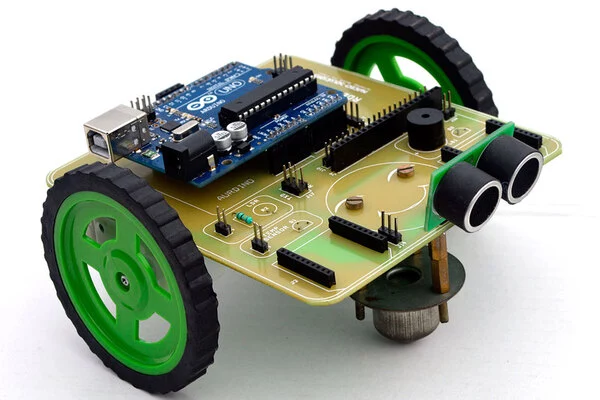Researchers developed a robotic system that allows a low-cost and relatively small-legged robot to climb and descend stairs nearly its height, traverse rocky, slippery, uneven, steep, and varied terrain, walk across gaps, scale rocks and curbs, and even operate in the dark.
This tiny robot can go almost anywhere.
Researchers at Carnegie Mellon University’s School of Computer Science and the University of California, Berkeley have developed a robotic system that allows a low-cost, relatively small-legged robot to climb and descend stairs nearly its height; traverse rocky, slippery, uneven, steep, and varied terrain; walk across gaps; scale rocks and curbs, and even operate in the dark.
“Improving the ability of small robots to climb stairs and handle a variety of environments is critical to developing robots that will be useful in people’s homes as well as search-and-rescue operations,” said Deepak Pathak, an assistant professor in the Robotics Institute. “This system generates a robust and adaptable robot capable of performing a wide range of everyday tasks.”
This system uses vision and feedback from the body directly as input to output commands to the robot’s motors. This technique enables the system to be very robust in practice. It can recover if it slips on the stairs. It has the ability to adapt to new environments.
Ananye Agarwal
The team put the robot through its paces, testing it on uneven stairwells and hillsides in public parks, challenging it to walk across stepping stones and over slippery surfaces, and asking it to climb stairs that would be equivalent to a human leaping over a hurdle for its height. By relying on its vision and a small onboard computer, the robot adapts quickly and masters difficult terrain.
The researchers practiced walking and climbing on difficult terrain with 4,000 clones of the robot in a simulator. The speed of the simulator allowed the robot to gain six years of experience in a single day. The simulator also recorded the motor skills it learned during training in a neural network, which the researchers then transferred to the real robot. Unlike traditional methods, this approach did not necessitate any hand-engineering of the robot’s movements.
Most robotic systems use cameras to map their surroundings and then use that map to plan movements before carrying them out. The process is slow and prone to stuttering due to inherent fuzziness, inaccuracies, or misperceptions in the mapping stage, which affect subsequent planning and movements. Mapping and planning are useful in high-level control systems, but they are not always appropriate for the dynamic requirements of low-level skills such as walking or running over difficult terrain.

The new system skips the mapping and planning phases and directly routes vision inputs to the robot’s control. The robot’s movement is determined by what it sees. The researchers do not even specify how the legs should move. This technique enables the robot to react quickly to approaching terrain and move through it effectively.
The robot itself can be low-cost because there is no mapping or planning involved, and movements are trained using machine learning. The team’s robot was at least 25 times less expensive than available alternatives. The algorithm developed by the team has the potential to make low-cost robots much more widely available.
“This system uses vision and feedback from the body directly as input to output commands to the robot’s motors,” explained Ananye Agarwal, a machine learning Ph.D. student at SCS. “This technique enables the system to be very robust in practice. It can recover if it slips on the stairs. It has the ability to adapt to new environments.”
This direct vision-to-control aspect was inspired by biology. Vision is used by humans and animals to move. Try running or balancing while closing your eyes. Previous research by the team demonstrated that blind robots (robots without cameras) can traverse difficult terrain, but adding vision and relying on it greatly improves the system.
The team looked to nature for other elements of the system, as well. For a small robot – less than a foot tall, in this case – to scale stairs or obstacles nearly its height, it learned to adopt the movement that humans use to step over high obstacles. When a human has to lift its leg up high to scale a ledge or hurdle, it uses its hips to move its leg out to the side, called abduction and adduction, giving it more clearance. The robot system Pathak’s team designed does the same, using hip abduction to tackle obstacles that trip up some of the most advanced-legged robotic systems on the market.
The movement of four-legged animals’ hind legs also inspired the team. When a cat moves through an obstacle, its hind legs avoid the same objects as its front legs because they lack the benefit of a nearby set of eyes. “Four-legged animals have a memory that allows them to track their front legs with their hind legs. Our system operates in a similar manner “Pathak stated. The system’s onboard memory allows the rear legs to remember what the front camera saw and maneuver around obstacles.
“Because there is no map and no planning, our system remembers the terrain and how the front leg moved and translates this to the rear leg, doing so quickly and flawlessly,” explained Ashish Kumar, a Ph.D. student at Berkeley.
A low-cost #robot ready for any obstacle @carnegiemellon https://t.co/zKqcSHDXY5
— TechXplore (@TechXplore_com) November 16, 2022
















